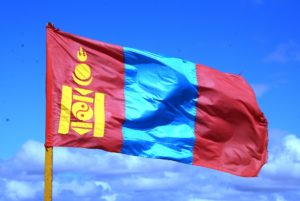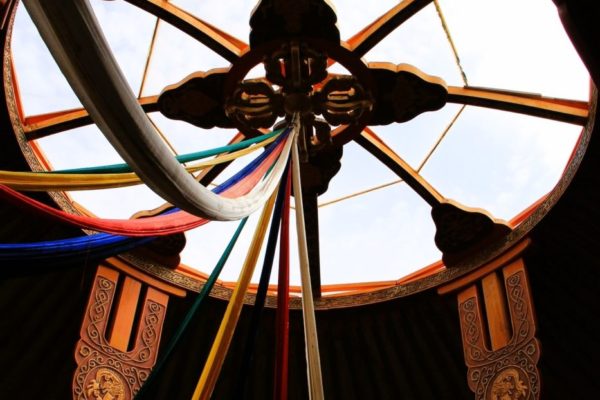State Symbols
The state symbols of Mongolia include the National Emblem, National Flag, National Anthem, State Great White Coat of Arms, Military Great Black Coat of Arms, State Palace, State House of Honor, State Order Medal, and others.
Mongolian Flag
 The Mongolian national flag is made up of a combination of red and blue colors. The middle part of the flag is blue, symbolizing the eternal blue sky, and the two sides are red, symbolizing the sunrise. In the center of the red background on the east side of the flag is the Golden Soyombo, representing Mongolian unity. The flag’s width and length ratio is 1:2.
The Mongolian national flag is made up of a combination of red and blue colors. The middle part of the flag is blue, symbolizing the eternal blue sky, and the two sides are red, symbolizing the sunrise. In the center of the red background on the east side of the flag is the Golden Soyombo, representing Mongolian unity. The flag’s width and length ratio is 1:2.
The Great White Flag
The Great White Flag is a symbol of the state’s honor. It was erected by Genghis Khan after establishing the Great Mongolian Empire. It is made using the hair of a white and light stallion, which is a symbol of “strengthening the state of Mongolia with the power of a thousand white stallions”.
The three forks on the top of the flag are made of steel and four steel rings are present on both sides, containing the symbol of the flame of fire. The steel ring represents strength. At the bottom of the three-pronged fork of the Great White Flag, a white envelope is made to imitate the great white house, and the wall of the house is represented by a network of bent white hairs.
There are tongues hanging from the four directions, which also represent the four legs of the state. It moves with the wind, which shows “the greatness of the country and the desire to develop forward”. The belt of four legs is a symbol of “the strong existence of the country forever”. The four mirrors are a symbol of “looking at all the good and bad things happening in the four directions, raising the country like a mirror and watching out for foreign enemies.”
Legacy
The Great White Flag of the State consists of the “Great River Flag” and the “Eight Small Flag Flags” surrounding it. The white flag of Tsagadai Khan was preserved in the National Museum of Mongolia. According to the explanation, the White Flag of Lu Janjin of the province was said to be the White Flag of the province. This flag later became an important legacy for the restoration of the “Nine-Legged White Banner”. In the historical period, “White Banner Foundation”, “White Banner Sacrifice”, and “White Banner Yesterday” were created, and “Ezensan or Bogd “Genghis Khan’s Foundation” has remained a word of mouth among the Mongolian people.
Population and density
Mongolia is a landlocked country located in central, east Asia, bordering Russia to the north and China to the east, south, and west. The country has a population of approximately 3 million people, with a growth rate of 2.8%. Two-thirds of the population is below 30 years of age, and the majority of the citizens reside in the capital city of Ulaanbaatar, where more than one million people live. The city is still expanding every year, and the average population density is 1.7 square kilometers, while in the Gobi desert, the density is only about 0.4 square kilometers.
Geographic Information
Mongolia is the 18th largest country in the world and the 6th largest in Asia with a total land area of 1,566,500 sq. km. It covers 1.05% of the total land area on Earth. Mongolia is the world’s second-largest landlocked country and ranks first in the world in terms of land area per capita. The northernmost point of Mongolia is “Mongol Sharyn Davaa” at 52.09 north latitudes, while the southernmost point is “Orvog Gashuunii Bor Tolgoi” at 41.35 north latitudes. The westernmost point is “Maanti Mountain” of Altai Tavan Bogd Mountains, 87.44 east longitudes, and the easternmost point is “Modot Khamar” of Hyangan Mountains, located at 119.56 degrees east longitude, respectively. The Central Point of Mongolia is located 13.5 km south of the center of Burd Sum in Uvurkhangai province. It is positioned at 46.52 north latitude and 103.50 east longitude, or at the beginning of Uvurkhushuut spring. The distance from north to south is 1259 km, from west to east is 2392 km, and the total length of the border circle is 8158 km.
The landscape of Mongolia is mostly mountainous, with most of the country elevated about 1500 meters from sea level. The lowest point in the country is Blue Lake of eastern Mongolia, which is 557 meters above sea level, while the highest point is Khuiten Peak in the Altai Mountain range, which stands at 4374 meters above sea level.
Regions
Mongolia’s landscape is divided into four main regions: the mountainous alpine region, the mountainous steppe region, the semi-desert region, and the desert region. The country has three main mountain ranges, including the Khan Khentii Mountain Range, Khangai Mountain Range, and Mongol Altai Mountain Range. The southern part of the country is covered by the Gobi desert, while the eastern part is characterized by the steppe. Mongolia is home to several lakes, including the biggest lake, Uvs Lake, which is 3360 square kilometers wide, and the Khovsgol Lake, which is the biggest freshwater lake in Central Asia, covering an area of 2758 square kilometers.








